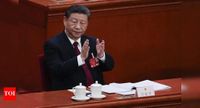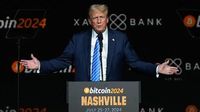In a significant escalation of global trade tensions, US President Donald Trump announced that India will face reciprocal tariffs starting April 2, 2025. This unexpected move is poised to severely affect India's exports, particularly in the agricultural and pharmaceutical sectors, which have been identified as having high tariff differentials with the US.
Trump, speaking in an interview with Breitbart News, voiced his discontent with India’s trade practices, stating, "I have a very good relationship with India, but the only problem I have is they are one of the highest tariffing nations in the world. I believe they’re probably going to be lowering those tariffs substantially, but on April 2, we will be charging them the same tariffs they charge us.”
This announcement follows recent statements from officials in India’s Commerce and Industry Ministry who indicated a plan to engage with stakeholders to resolve outstanding issues in the bilateral trade agreement (BTA) that both nations aim to sign by the end of 2025.
The ongoing trade friction is not limited to just agricultural goods. Sectors such as steel and aluminum are already suffering under the weight of 25% tariffs imposed by the US on these metals, leading industry representatives to claim that approximately $5 billion worth of exporters are feeling the impact of Trump’s new tariffs.
Consequently, there are additional proposals from the anti-dumping watchdog under the Commerce Ministry to impose a 12% duty on certain imported steel products, which could potentially hike domestic prices even further.
According to data from SBI research, the average US tariff rate on Indian goods saw an increase from 2.72% in 2018 to 3.91% in 2021, easing slightly to 3.83% in 2022. At the same time, India’s tariffs on US imports rose from 11.59% in 2018 to 15.30% in 2022, indicating growing friction.
Despite these tensions, there have been indications that India may be willing to negotiate tariff reductions. During a previous meeting in February 2025 between Trump and Indian Prime Minister Narendra Modi, India expressed willingness to reduce tariffs on a variety of products. Notably, it has already made concessions in lowering duties on imports of bourbon whiskey and high-end motorcycles, showcasing its intent to ease trade pressures.
A recent Goldman Sachs report offered insights into how these tariffs may play out, suggesting that reciprocity could be the simplest method of approach. However, if applied at the product level, it could increase the average tariff differential by approximately 11.5 percentage points, complicating trade relations further. Moreover, if Trump leverages non-tariff barriers such as licensing and subsidies, it would pose even more significant challenges, reflecting the complexity of international trade relations.
The magnitude of Trump’s tariffs is not just confined to US-India relations but has broader implications affecting the global economic landscape. Chinese manufacturers, facing rising trade barriers in the US, are rapidly redirecting excess exports to markets like Mexico, Indonesia, and India, leading to significant disruptions in local industries.
As mentioned in a Bloomberg report, the phenomenon often referred to as the “China Shock” is witnessing a resurgence. Countries that were once insulated are now grappling with adverse economic impacts due to influxes of low-cost Chinese goods. For instance, Indonesia's textile industry has lost roughly 250,000 jobs in the last two years, with another 500,000 at risk by 2025. This stark reality reflects the broader economic threats posed by the ongoing trade wars.
In India, local textile producers have been particularly hard hit, struggling to compete against the influx of inexpensive Chinese garments. The authorities have launched anti-dumping probes targeting various Chinese products, including solar cells and mobile phone components, to shield domestic industries against this overwhelming competition.
Reports indicate a grave concern among economists who warn that turmoil caused by escalating trade disputes could push the global economy towards a recession, heightening inflation rates while stalling investment prospects. Federal Reserve Chair Jerome Powell recently remarked, “Uncertainty is remarkably high,” underscoring the net effect of current trade policies.
The complex trade dynamics come at a time when Trump’s policies are also benefiting certain Indian sectors, such as automotive and chemicals, as US companies look for alternative suppliers amid the ongoing tariff-induced chaos with China. While this may provide a silver lining, it also places India in a precarious position regarding trade negotiations with the US.
As April 2 approaches, the Modi government will likely expedite discussions regarding further tariff reductions. However, the overarching question remains whether these adjustments will appease the Trump administration or lead to intensified negotiations. Moreover, should trade tensions escalate further, the world faces the prospect of heightened economic hardship as industries scramble to adapt.
The impending tariffs symbolize not just a challenge for India but also reflect the intricate web connecting global trade dynamics, revealing the delicate balance nations must maintain amid rising nationalism and protectionist policies. The world watches closely as leaders react to the looming economic challenges and whether Trump’s hard approach will yield the intended results or spiral into a larger economic crisis.


